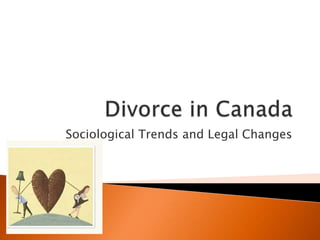
Divorce in Canada
- 1. Sociological Trends and Legal Changes
- 3. Nearly 30% of new couples are meeting online. (TIME Magazine, 2010) Facebook cited in 33% of divorce petitions (applications). (UK study, 2011) What is it about social media/online dating that creates such positive and negative circumstances for couples?
- 4. Why you think social media poses such a threat to married couples, specifically those having marital problems? Do you think this “online” problem will persist for married couples in the future? Why?
- 5. When marriage does not meet the expectations of 1 or both partners. Lack of marital satisfaction Rates fluctuate as a result of Social and Moral values Today: controlled by religion and government
- 6. Ancient Romans – purely family concern, rather than state governed. ◦ Very attainable, happened frequently Early Christians (11th-12th cent) ◦ First consideration from a religious standpoint. Catholic Church – Marriage as a Sacrament ◦ Marriage as a sacred rite, spiritual importance. ◦ Divorce was the breaking of something sacred.
- 7. Functionalist perspective (stability created by roles and division of labour) Traditional (economic, childrearing basis) Divorce meant suing for “matrimonial offence” (adultery and cruelty)
- 8. Romance as the basis for marriage. Assessment of satisfaction = how happy are you? Divorce treated as “marriage breakdown” Divorce law reflects love and companionate purposes of marriage.
- 9. Divorce is increasingly common Divorce law decreases the time required to get a divorce.
- 10. • Constitution Act • Marriage and Divorce federally governed 1867 • 1925 – Adultery grounds for divorce (for women) • Divorce Act -“Marriage Breakdown” after 3 years of separation • Sharp increase in divorce rates 1968 • Divorce Act – 1 year of separation before divorce. • “No Fault” divorce 1986 • Sharp increase in divorce rate.
- 12. One person requests/initiates Recognition of ongoing problems Denial until confronted by request for divorce Begin shifting energy to outside roles
- 13. Plan the break up Settle child custody and finances Notify friends, family & coworkers 2 new households
- 14. Establish 2 separate lives (social, financial) Form new social life as a single person Negotiate new parental roles
- 15. In 1985 what changes were made to the Divorce Act? What is the “single ground” for divorce? What three conditions can give reason for divorce? Define separation. Outline the conditions surrounding the process of separation. Adultery and cruelty are still considered to be “matrimonial offences”. Outline how these offences can and cannot be used as grounds for divorce. What kind of evidence is needed to prove the presence of adultery or cruelty? Why are these “offences” treated differently?
- 16. What can these artworks tell us about divorce as a legal, emotional and physical process?
- 23. The Legal and the Real
- 24. Divorce doesn’t end on paper or in court After legal divorce there are emotional and practical issues to cover Consequences are complex, and so are they emotions New individual developmental tasks
- 25. Arrangements for property, possessions, children and spousal support
- 26. Legal action taken to keep the peace, protect yourself, children and property.
- 27. Only when disagreements cannot be resolved. Law imposes a decision on the situation.
- 28. If kids are involved, Judge will consider both partners’ requests. Reasonable? Supported?
- 29. Don’t expect too much from legal divorce Finalization won’t solve all problems Setting themselves up for frustration or disappointment
- 30. The reality and feelings that hit post-divorce Dealing with: ◦ Feelings ◦ Finances ◦ Friends and Family
- 31. Ending one life, beginning another Breaking old patterns New Balance
- 32. Breaking emotional bonds Habits and dependencies that connect you to your spouse. Letting Go: anger, guilt, blame, fear, resentment, tension. Achieve neutral view of ex-spouse Self-confidence and new openness.
- 33. Mind and body cannot be separated! Internalized stress and feelings cause physical symptoms Tension, stress, anxiety lead to illness Rates of suicide, accident victims & physical illness
- 34. Listen to your body Indicator of mental and emotional heath
- 35. “taking care of business”, making ends meet. Safety, security, stability for you & children Financial realities for men and women
- 36. Greater earning Lower earning potential potential More likely to remarry Less likely to remarry More likely to have Higher standard or custody living Very low standard of living Men Women
- 37. 10% of those divorced feel that their life is better. 20% feel that quality of life is significantly worse.
- 39. A legal contract Summarizes obligations to one another Finances, property, children Can be made before of after marriage Promises to each other.